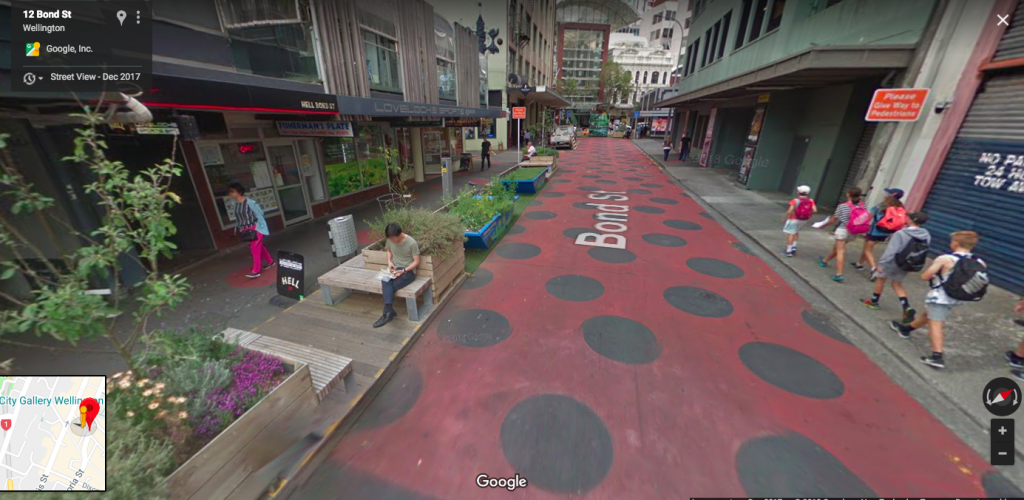On the frontlines of tactical urbanism: lighter, quicker, cheaper with Steven Burgess
“We shape our streets, and thereafter they shape us” – but then we can shape them back. And it needn’t be a huge, expensive, fraught undertaking. Tactical urbanism guru Steven Burgess has been in Aotearoa-NZ, rattling a few cages and opening eyes, and guest poster Braden went along.
We have the recording! Find it on our latest post: Give it a whirl
What is tactical urbanism anyway?
Say you think your street’s a bit of a crappy place to be, and want to improve the experience it gives people.
Instead of doing options testing on paper and trying to figure out what will work best before crossing your fingers and implementing it for real, you do 1:1 scale trialling – get real feedback from people in real life, and everyone can see what’s working and tweak things as you go. Then, after a good period of this, you decide together whether or not to keep it – informed by rich real-life data. This is tactical urbanism.
It’s not guerilla urbanism – it’s done officially. It’s not a popup never intended to stay – it’s with a view to long term improvement in that spot.
It’s giving things a real try, with an attitude of “let’s give it a whirl and see, together!”
- Let’s try some skinnier traffic lanes and wider footpaths for a few months, see if people actually kill or injure each other (as the doomsayers claim), or if they’ll actually respond to the environment and each other
- Let’s try if people like being able to sit down and have their coffee and a chat in a nice mini patio with plants – right here where there’s now a carpark
- Let’s see if we can get people out of their cars and lingering and spending in five or six local shops, instead of doing a grab-and-dash pit-stop on the way somewhere else
- Let’s see if people like having a space to hang out and meet and eat lunch that’s free for all, and pleasant to be in, hey we could make it out of this big bit of asphalt…
Steve Burgess has done a lot of this stuff around Australasia (he’s also an expert on parking). He’s a great speaker – punchy, clear, sweary in that quintessentially Aussie way which is somehow okay, and insightful. Here are some bits that stuck out for me.
A few pearls from the talk On the Frontline of Tactical Urbanism
- What we say we want isn’t what we care about (and sometimes the “want” stuff undermines what we care about)
When you ask people what they want to see on a street or space, or when they come to you angry (usually) about something, it’s often “more parking, our businesses are suffering cos people can’t find a carpark” or “there’s too much congestion we need more road space”.
And ask us directly whether we want to turn some space that’s been used for cars to being only for people, and we’ll invariably say “No! We’d lose something important! What do you mean cars aren’t helping here? Go away you’re so out of touch, [Council] idiots”.

But what do these angry or worried people actually care about? It’s always something bigger:
“My business is declining and I’m worried about my livelihood, and it feels like it’s all on me (and out of my control) at the same time”.
“I’m spending too much time on travelling (and – enragingly – sitting in traffic) that I should be spending on family, friends, work…”.
And those people who said “No way José” to the “loss” of car space on a street are invariably amongst the overwhelming majority of folks who actually care most of all about public spaces being green, safe, universally accessible, welcoming, clean – easy to park in or drive past is a long way down the list.
For example, in rigorous research of what 3,000 Sydneysiders cared about most in their streets, ease of parking was the highest-ranking car-related thing and it came in 27th – 27th – behind a slew of other people-centric values. Greenness, safety, accessibility, welcome, and being clean were invariably in people’s top 5 or 10.
2. We’re now crap at building streets that people like to be on.
Like everyone else who’s heard a talk or a class or a course from Steve Burgess, we volunteered our favourite street in the world, and why we like it. He listened, then observed, “from about 10,000 people who I’ve spoken to over the years, two individuals – two – have said streets that were built after about 1945-1950. What’s that about? What happened around then? And why, with all our modern transport and traffic engineering, urban design, urban planning, and the millions of streets we’ve built with all this since then, can’t we now make one that people like?”
“No-one’s favourite streets were built later than 1945 because then we started building them to be fabulous if you’re a car. If you’re a human, they’re a bit shit. You don’t like being there once you’re not in a big tin can.”

3. We’ve made loads of rules that say “you can’t build human-scale streets”
Now we’re not allowed to build a street of the scale and the “stickiness” that people like to be on. The Austroads guidelines [PDF], adhered to religiously by the road design establishment, say you have to have this width and that amount of parking so this volume of cars can move freely through it, so obviously they need this much space. People – the point of cities – are literally pushed to the edges. Traffic engineering, constrained by these rules, has been given the first cut at all our roads and streets – so doing right by their trade, they design according to the rules.
It’s good if you’re a car but it’s terrible for humans – but that’s the rules we’ve made ourselves.
We build places to live that are objectively bad for humans – they suppress our natural physical activity, our ability to know our neighbours, our tendency to walk down to the local shops and drop in and say hi to people. You have to hop in the car to do almost everything outside your property.

And we’re still building them.
5. Change is easier if you’re giving it a whirl together
We don’t know how to do this people-centric streets stuff. We’ve forgotten (if we ever knew in Australasia).
So don’t do the traditional “waterfall” design and planning process led by experts that ends up with option that offends the least people being Built (with everyone’s fingers crossed it will work because your town’s never done this before and the councillors will have your guts on a stick if it doesn’t work).


Instead, give some stuff a whirl and monitor the hell out of it, transparently, and when people say “this bit’s really awkward” or “you’ve put the seat in a really windy spot” you can tweak it and go “ok, how’s it feel now?”
You do this and do this and see how it’s working, and eventually people will be in a position to make a call about whether they want the changes to stay. And nine times out of ten they do! Makes sense really: they’ve been able to actually experience it, not just look at visualisations or pictures, and the problematic kinks have been sorted out.
6. FFS learn – and do it transparently, together
Tactical urbanism is about learning. Everyone can see and experience, and everyone should see the data about how it’s working – from human experience and from gadgets.
What surprised us – what turned out to work, or not work, against our or my expectations?
- Did we think it’d be carmageddon and congestion (of course, or at least lots of people did) – but was it really? Really?
- Did the urban designers’ ideas actually work in practice once real people could have a go experiencing them?
- What did people who used it actually feel? No, really, did we ask them how they felt in it?
- What little tweaks were effective at ironing out niggles, which we should remember for any other street?
What ways of doing things together were more effective or even more fun?
- Is it actually worth the hassle of going around my neighbouring businesses and us coordinating so we can hunt as a pack?
- Did it work to try to bring people together for meetings at Council, or was it better to have them on the street?
- For once Council didn’t “own” this one, what worked and didn’t work about that?
Wellington’s flirted with tactical urbanism – Bond St, below, is our best example.

But recently, we’ve not done it very well.
Reimagining Tory Street experienced classic “what I want” vs “what I care about” reaction, amped up in this DomPost piece (some thoughtful coverage by Newshub here) and was wrapped up and put back to car-only space despite being a decent stab at a tactical urbanism project.
Did we learn anything, apart from “it’ll be kinda cool, but some people will yell lots then Council will never talk about it again?”

Further thinking and reading
- Where in your ‘hood would you like to see some tactical urbanism trying new layouts for the street?
- Can we try some to reshape the city streets ahead of Let’s Get Wellington Moving?
- Mark your diary and bring the kids (and bikes, kites, mini soccer ball) for a large-scale one-day popup of people-centric open streets: Wellington Open Streets, Te Ara Tapere o Pōneke, 28th October!
- Listen to Steven Burgess in conversation with Wellington’s Bryan Crump on Radio NZ
Image credits:
- What we want/need – stock photo
- Google streetviews
- Penrith park before and after – from Street-plans
- Bond St – supplied to Stuff.co.nz
Leave a comment